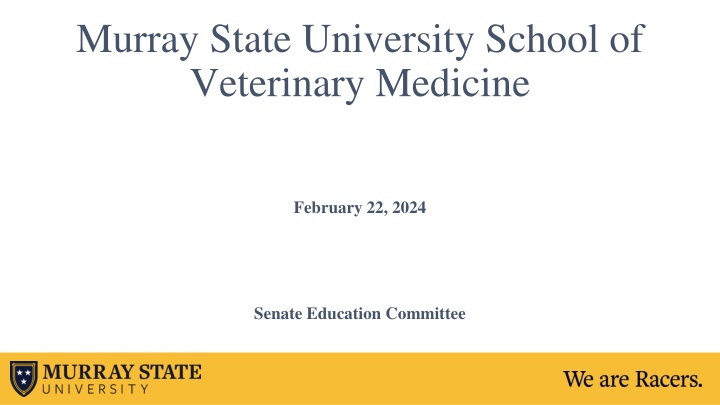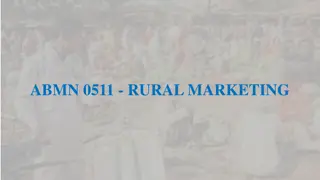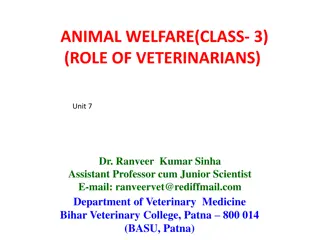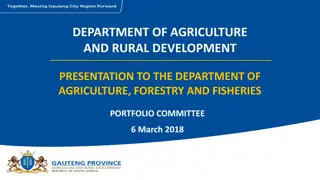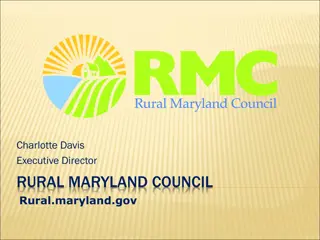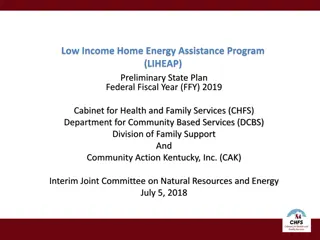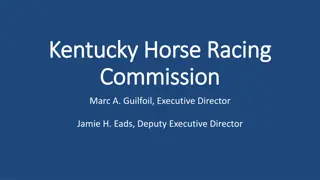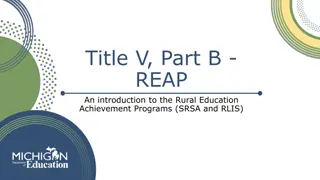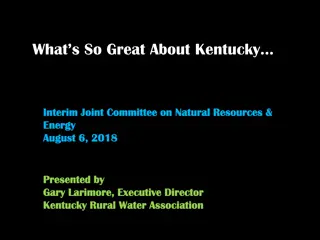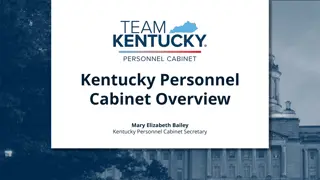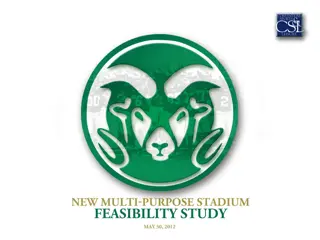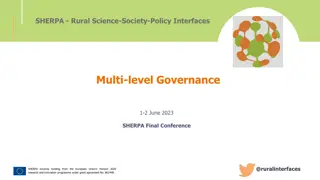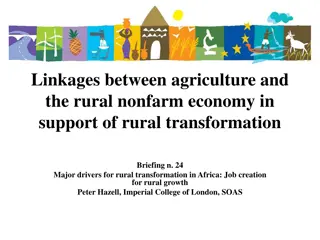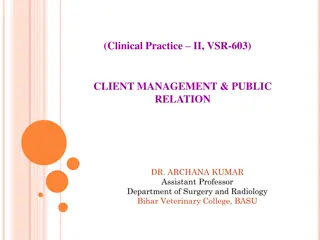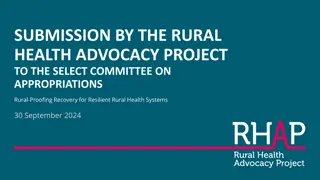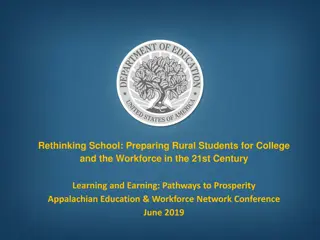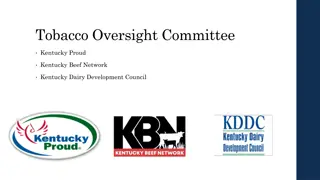Addressing the Need for Rural Veterinarians in Kentucky: A Feasibility Study
Murray State University's Hutson School of Agriculture is well-positioned to meet the increasing demand for rural veterinarians in Kentucky. With a focus on training students for rural and large animal veterinary practices, the school's distributed learning model offers real-world immersion and industry-standard equipment exposure. Kentucky faces a shortage of such veterinarians, putting herds and flocks at risk. The proposed approach aims to bridge this gap by tailoring student clinical experiences, enhancing stakeholder engagement, and reducing construction costs significantly.
Download Presentation

Please find below an Image/Link to download the presentation.
The content on the website is provided AS IS for your information and personal use only. It may not be sold, licensed, or shared on other websites without obtaining consent from the author.If you encounter any issues during the download, it is possible that the publisher has removed the file from their server.
You are allowed to download the files provided on this website for personal or commercial use, subject to the condition that they are used lawfully. All files are the property of their respective owners.
The content on the website is provided AS IS for your information and personal use only. It may not be sold, licensed, or shared on other websites without obtaining consent from the author.
E N D
Presentation Transcript
Murray State University School of Veterinary Medicine February 22, 2024 Senate Education Committee
Feasibility Study- Peake et al. Murray State University s Hutson School of Agriculture, which currently serves approximately 1400 students, is perfectly positioned to address the growing need for rural veterinarians in KY. Well established network across KY - in all 120 counties - through dual credit courses. KY has a need for rural and large animal veterinarians that has not been met by the current approach to training students.
Kentucky Veterinarian Status Data from the Board of Veterinary Examiners identify 1,564 practicing veterinarians with addresses in Kentucky and 2,613 licensed veterinarians in total. Largest concentration are practicing in urban counties near Louisville and Lexington. Just over half of Kentuckians who benefit from the veterinary contract spaces program at that institution return to Kentucky to practice after graduation.
Future Veterinarian Needs Data Sources: AVMA 2023 State of the Profession Veterinary positions will grow by 19.3% between 2016 and 2026, with 704 total openings during that time. Veterinary Medicine is a fast growing occupation in Kentucky. The shortage of rural food animal veterinarians available for herd health visits/consultations, surgery and emergency after hour visits is putting Kentucky producer s herds and flocks at risk. In the absence of veterinary consultation, producers may use veterinary pharmaceuticals inappropriately, putting a potentially dangerous product into the food chain. (USDA NIFA, 2023,paragraph 10).
Future Veterinarian Needs Data Sources: AVMA 2023 State of the Profession There are currently 32 Colleges/School of Veterinary Medicine in the United States. 22 States do not have veterinary schools and each year there is a shortage of seats for students interested in studying veterinary medicine.
The Clinical/Distributed Model Distributed learning is an instructional model that allows instructor, students, and content to be located in different, non-centralized locations so that instruction and learning can occur independent of time and place. Real world immersion modeled after human healthcare education Networking & job offers Tailor student clinical year focus Student creates their own geography Industry standard equipment exposure Clinical partners screen and hire top students Increased stakeholder engagement in training students Reduced construction cost (approximately $150 million)
The Clinical/Distributed Model IMPORTANT Accredited same way Same licensure exam Selected Current Vet Schools under this model Texas Tech Clemson University University of Arizona Lincoln Memorial University Calgary University Long Island University
VISION OF MSU SCHOOL OF VETERINARY MEDICINE Curriculum: Clinical/Distributed Model of Veterinary education program; preclinical training at the new Murray facility, clinical partnership training with existing practices, non-profits, and industries Class Size: up to 70/class with a focus on rural Kentucky and large animal practices $4.2 Million incentive scholarship endowment
Existing Support Structure at Murray State 1. 2. 3. 4. 5. 6. Rudolph Equine Education Center West Farm Complex, which houses the university s certified Angus herd North Farm Complex, which houses the university s swine unit Breathitt Veterinary Center, a veterinary diagnostic laboratory Carman Pavilion Pre-Vet/Vet Tech Teaching Facility Currently employ 11 veterinarians and 40 Veterinary Practice and Diagnostic Technicians Strong Pre-Vet and Vet Tech program, over 450 students 7.
How We Get them to Stay in KY and Practice in Rural Areas - The Grassroots Approach Currently, the Hutson School of Agriculture at Murray State University has dual credit system with high schools in every county of the Commonwealth (this semester ~1000 students) We must identify rural youth with desire and potential in 10thgrade Deliver dual credit sciences and support to those students Bolster the pipeline with capable Vet School applicants
How We Get them to Stay in KY and Practice in Rural Areas - The Grassroots Approach Provide scholarship incentive to rural pre-vet students who want to return to large animal/mixed practice. New endowment to support rural students studying veterinary medicine- $4.2 million Admission to MSU Vet School criteria clearly defined and transparent Reduce the debt burden Tuition Model - lower tuition and fees than KY students currently pay to attend Auburn. Considerably less than several private schools
Potential Impact Job Creation: The new school will help address the shortage of veterinarians in Kentucky. An estimated 50 70 veterinarians graduate each year with an increased likelihood to remain in Kentucky. Emergency veterinary care facility Bolster potential veterinarians from rural areas
Students are our Focus! It isn't just a passion, it is a dream for most of us. Going through your undergraduate years and spending all the time taking the hard classes and not get accepted into a Veterinary School is very discouraging. Everyone always says, "follow your dreams," however that is not possible unless you get accepted.
